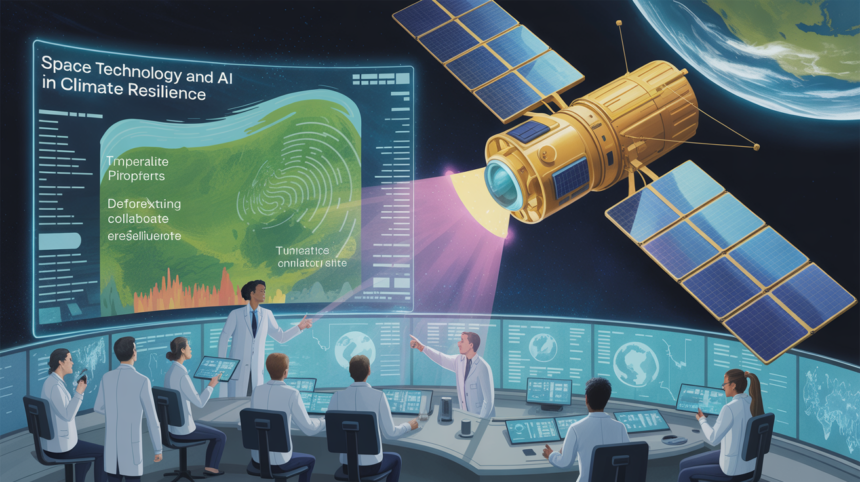Climate change is one of the biggest challenges facing the world today. It brings extreme weather, rising sea levels, and threats to food and water security. But there is hope. Space technology and AI in climate resilience are helping us understand, prepare for, and fight these changes better than ever before. This blog will explain how these tools work, why they matter, and what they mean for our future.
What Is Climate Resilience and Why Does It Matter?
Climate resilience means being able to handle the effects of climate change without suffering too much damage. It’s about adapting to floods, droughts, storms, and heatwaves so communities, ecosystems, and economies can keep going strong.
But climate change is complex and fast-moving. To build resilience, we need detailed, real-time information about the Earth’s systems — like weather patterns, ocean health, and land use. This is where space technology and AI in climate resilience come in.
How Space Technology Helps Us Monitor the Earth
Satellites orbiting the Earth collect vast amounts of data every day. They take pictures, measure temperatures, track storms, and monitor forests and oceans. This is called Earth Observation (EO).
Thanks to EO satellites, scientists can:
- Track hurricanes and warn people early
- Monitor droughts and water supplies
- Measure greenhouse gas levels
- Detect deforestation and land degradation
- Study ocean temperatures and coral reef health
Satellites give us a global view that ground sensors alone cannot provide. They help governments and organizations make better decisions to protect people and nature.
The Role of AI in Making Sense of Big Data
Satellites send back huge amounts of data — too much for humans to analyze quickly. This is where Artificial Intelligence (AI) shines.
AI uses smart algorithms and machine learning to:
- Process satellite images and spot patterns
- Predict extreme weather events before they happen
- Model climate impacts on crops, water, and cities
- Help design better infrastructure to withstand climate risks
By combining space technology and AI in climate resilience, we get faster, more accurate insights. This helps communities prepare and respond better.
Real-World Examples of Space Tech and AI in Action
Early Warning Systems for Disasters
Satellites detect floods, wildfires, and storms early. AI analyzes the data to predict how these events will unfold. For example, when a hurricane forms, satellites track its path, and AI models its strength and impact zones. This gives people time to evacuate and governments time to prepare.
Smart Agriculture
Farmers use satellite data and AI to monitor soil moisture, crop health, and weather forecasts. This helps them decide when to plant, irrigate, or harvest, reducing water waste and improving food security.
Urban Planning and Infrastructure
Cities use satellite maps and AI to identify flood-prone areas and plan resilient infrastructure. This includes building better drainage systems and designing green spaces that absorb rainwater.
Emerging Space Technologies Boosting Climate Resilience
New types of satellites, like CubeSats and SmallSats, are cheaper and faster to launch. They provide more frequent data updates. Advances in satellite communication allow real-time data sharing, making AI predictions even more timely.
Space-based solar power is another exciting innovation. It aims to collect solar energy in space and beam it to Earth, providing clean, constant energy to reduce reliance on fossil fuels.
Challenges and Future Directions
While space technology and AI in climate resilience offer great promise, challenges remain:
- Data privacy and security
- High costs of satellite missions
- Need for better global cooperation
- Ensuring AI models are transparent and unbiased
Scientists and policymakers are working to overcome these hurdles. The future will likely see more satellites, smarter AI, and stronger partnerships to protect the planet.
How You Can Support Climate Resilience
Even if you’re not a scientist or policymaker, you can help:
- Support clean energy and sustainable products
- Stay informed about climate science
- Advocate for investments in space and AI technologies
- Use apps and tools powered by satellite data to reduce your carbon footprint
Every action counts in building a resilient future.
Summary: Why Space Technology and AI Matter for Climate Resilience
- Climate resilience is vital to adapt to and mitigate climate change impacts.
- Satellites provide global, real-time data on Earth’s systems.
- AI processes vast data to predict disasters and model impacts.
- Together, they enable early warnings, smarter farming, and resilient cities.
- Emerging tech like CubeSats and space solar power will enhance efforts.
- Challenges exist but are being addressed through innovation and cooperation.
Frequently Asked Questions (FAQs)
What is climate resilience?
Climate resilience means the ability to withstand and recover from climate change effects like floods, droughts, and storms.
How do satellites help with climate change?
Satellites monitor weather, land, and oceans, providing data to track changes and predict disasters.
What role does AI play?
AI analyzes large satellite datasets to identify patterns, forecast events, and guide decision-making.
Can space tech and AI prevent climate disasters?
They can’t prevent disasters but help detect and respond to them faster, saving lives and property.






